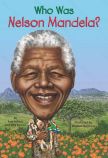Who Was Nelson Mandela?
 Who Was Nelson Mandela ?
Who Was Nelson Mandela ?
Non Fiction / Biography
Grosset & Dunlap, an imprint of Penguin Group
2014
105 pp.
ISBN-13: 978-1-48980-566-9

Includes bibliographical references (pages 104-105).;Who was Nelson Mandela? -- Troublemaker -- City of light -- Apartheid -- The defiance campaign -- Sharpeville -- Underground -- Robben Island -- Free Mandela -- State of emergency -- President Mandela. A biography of Nelson Mandela, South African anti-apartheid activist, political prisoner, and president.
This biographical sketch of Nelson Mandela gives a decent overview of the social and political context in South Africa that gave rise to Nelson Mandela and his leadership in the struggle against racial oppression in South Africa. Also useful are the pages dedicated to comparisons—to Jim Crow in the U.S.; to other great civil rights leaders, Gandhi and Martin Luther King Jr. Unfortunately, the book has numerous factual errors and stereotypes.
On page 2 the authors assert that “(o)nce black kings had ruled South Africa. Then white settlers came from Europe.” In pre-colonial South Africa there were a number of important kings/kingdoms (e.g. Zulu and Sotho) but many South Africans lived in de-centralized societies that were complex in structure, but were not ruled by kings. On page 23, the Nationalist party is described as starting segregation, “The government of South Africa started a cruel system of segregation . . .” While it is true that apartheid was a particularly egregious form of legalized discrimination, it was not new—it was the culmination of centuries of increasingly brutal segregation, discrimination, and separation. On page 53, the authors assert that when the Sharpeville massacre occurred “(f)oreign businesses pulled their investment money out of South Africa.” While a few businesses did pull out at this time, the vast majority of international businesses (including most U.S. corporations) stayed until the 1980s, when growing international opposition to the apartheid regime forced them to divest. On page 100 the claim that after his retirement, Mandela moved back “to the village of his childhood” is only partially true. He did have a family home in his childhood home of Quno, but he spent most of his time in his Johannesburg home. Additionally their conclusion on page 69 that “[Winnie Mandela’s] beliefs became so different from Nelson’s that they divorced in 1996” is an opinion not a fact and it reinforces the idea that Winnie Mandela is politically extreme.
There are other problems. The use of the term tribe—tribal meetings, tribal elders, tribal language, throughout the book reinforce stereotypical (and inaccurate) representations of social and political structures in South Africa. The stereotype of African women as obese appears on page 19 when the authors quote Mandela’s description of the woman selected for him to marry as “fat and dignified.” Finally, I may be old fashioned but I found it disconcerting and border-line insensitive to refer to Mr. Mandela as “Nelson.” Most elementary and middle schools require students to address their teachers as Ms., Mrs., or Mr. Why then should a person who is almost universally revered as one of the great persons of the last century be reduced to “Nelson?”
Published in Africa Access Review (December 8, 2014)
Copyright 2014 Africa Access
Reviewed by: John Metzler, Michigan State Univeristy
